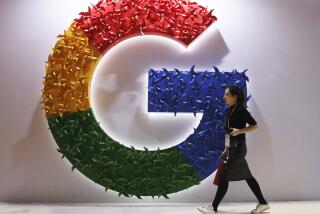Google Aspires Beyond Text Ads
- Share via
SAN FRANCISCO — Google Inc. has made a mint selling little text ads. But with a plan to help companies splash their names on targeted pages around the Web, the company has an ambitious new goal: to become the Internet’s ad agency.
From its modest beginnings as a search engine, Google created a lucrative business getting companies to pay each time someone clicked on short text ads appearing on its pages and those of its partners. Today the company is launching a campaign to sell animated display ads on other websites.
Analysts said the move could attract big-name advertisers that favor flashy Web ads promoting their brands. That would open a vast new pool of cash to a company that some have faulted for being too willing to spend on interesting ideas that have no clear way to make money.
Online ads generated $9.6 billion last year, according to the Interactive Advertising Bureau -- of which more than half was spent on display ads. That’s a big chunk of money that Google has largely conceded to such Internet giants as Yahoo Inc., Microsoft Corp.’s MSN and Time Warner Inc.’s America Online, which sell display ads on their sites.
Yahoo has similar ambitions to Google’s; the company, which acquired search-advertising pioneer Overture Services in 2003, has said it is creating a service for placing display and text ads around the Web.
But Google’s expansion into new forms of advertising demonstrates that the Silicon Valley company famous for its engineering prowess is determined to own that business.
“Google is not a technology company,” said Gary Stein, an analyst who follows Web advertising for Jupiter Research. “It’s a media company.”
The Internet giant’s explosive growth, highlighted by last week’s report of a nearly 500% jump in first-quarter earnings, has largely masked the fact that Google relies on one type of ad.
Text links delivered alongside search results on Google.com and websites operated by its partners account for 99% of Google’s revenue, which reached a record $1.26 billion the first three months of 2005.
“Google is a one-trick pony,” said Charlene Li, an Internet analyst with Forrester Research. “It’s a nice-looking pony. But they have to grab a bigger piece of the display advertising market.”
One effort to go beyond search-result ads has been Google’s “contextual ad” service, which places ads on the websites of thousands of partner companies, ranging from modest weblogs to big commercial websites. But the program hasn’t been as successful as Google’s search-engine advertising business, analysts said.
Advertisers have complained that their contextual ads -- automatically matched using keywords -- sometimes appear on pages that aren’t relevant. Other advertisers don’t buy contextual ads because they can’t control where they will appear.
The Google advertising program being rolled out today -- in limited form at first and more widely within a few weeks -- seeks to change that. Advertisers will be able to search Google’s database for websites relating to specific subjects, then bid on how much they’re willing to pay to place either text or display ads on each site. The program builds on a limited test of graphical ads launched on partners’ websites late last year.
As is typical with Google products, it puts a twist on a long-standing way of doing business. The system is an unusual hybrid of an ad pricing yardstick -- the cost per 1,000 impressions -- that most Web publishers use, and the cost-per-click model that Google and other search-engine providers use, analysts said.
Web merchants love cost-per-click ads, because they pay only when someone clicks on an ad. Consumers who click on a search-related ad also are more likely to be ready to buy than the average Web surfer.
But when it comes to the Internet, Procter & Gamble Co., McDonald’s Corp. and other deep-pocketed marketers that sell most of their products offline prefer attention-grabbing ads over mouse clicks. Although these companies increasingly are using the Web to support traditional advertising, they generally are more interested in priming consumers to want their products than in getting clicks.
Through the new Google program, brand advertisers will be able to choose which websites they want their ads to appear on, then name the top price they’re willing to pay per 1,000 impressions.
Google’s system will calculate which would generate more money -- one display ad or a cluster of text ads from other advertisers -- then display whichever has a higher potential value.
The new ad program will make Google “much more attractive to the brand owners,” said Danny Sullivan, editor of SearchEngineWatch.com.
Some companies that have avoided advertising with the company “might change their mind now,” he said.






